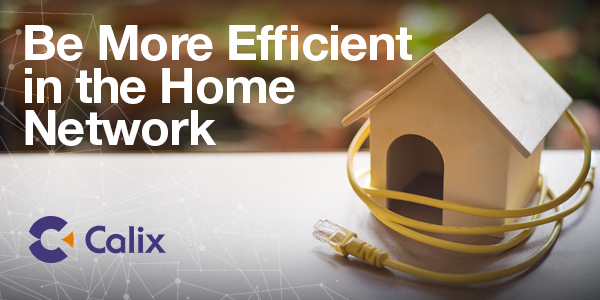When it comes to Customer Premises Equipment, Sometimes More is Less

There are two fundamental functions performed by customer premises equipment (CPE) in the context of telecommunications:
- Terminating the wide area network (WAN) connection from the access network, which might use one of several protocols, such as xDSL, GPON, Active Ethernet or coax. This is sometimes referred to as the demarcation point (or “demarc”) because it is the physical point where the access network ends and the home network begins; and
- Converting the incoming signal emanating from the access network into a technology that allows consumers to access communications services and distribute them around their house via a local area network (LAN).
Leap-frogging Technologies: Constant Innovation in both WAN and LAN Components
Over the past decade, both WAN and LAN technologies have experienced significant innovation. WAN technologies provided by telephone operators (telcos) have evolved from analog signals delivered over twisted copper pairs that provided ‘dial-up connections’ (which were limited to 128 kbps) in the 1980s and early 1990s, to broadband technologies that have included various types of DSL (also over twisted copper pairs) and PON (which uses fiber optical cables rather than twisted copper pairs). Today’s GPON connections can provide downstream bitrates of 2.5 Gbps and upstream bitrates of 1.25 Gbps. Future PON technologies, such as XGS-PON (10 Gbps symmetrical) and NG-PON2 (40-80 Gbps symmetrical) are likely to serve residential subscribers’ bandwidth needs for many years to come.
Given the relative maturity of fixed access technologies, and the fact that upgrading central office (CO) equipment (e.g., DSLAM and ONTs) requires significant investment from service providers, WAN technologies are not updated very often. In the case of PON, installed ONTs are expected to have a life of 5–10 years.
In parallel, LAN technologies have also been evolving, from using twisted copper pair RJ-45 connections, to Cat 5 and Cat 6 Ethernet. In the past decade, however, Wi-Fi has been growing in importance; to the point where 75 percent of in-home connections are made using Wi-Fi technology. To date, however, Wi-Fi technology does not match the speeds provided in the WAN, resulting in a ‘speed bottleneck’ in the home network. As a result, Wi-Fi protocols are changing at a more rapid pace than WAN technologies, with new, faster Wi-Fi standards emerging every 36–48 months.
The Evolution of the Customer Premises
Going back to the CPE for a moment; in many cases, the two core functions—terminating the WAN and distributing the connection around the subscriber premises via a LAN—have resided in the same piece of equipment, typically called a residential gateway (RG). In other words, subscribers would have a single device inside the home that not only terminated the connection from the access network (WAN), but also provided Wi-Fi functionality inside the home (LAN).
The challenge with this model is that every time the access network or Wi-Fi technology changes, new CPE has to be provided to the subscriber. As the industry strives to eliminate the bottleneck mentioned earlier that is caused by the lack of parity between the speeds that the WAN can deliver and the (lower) speeds that the LAN can deliver, most notably in PON networks, the CPE is often being replaced because the LAN connection is changing (e.g., 802.11n Wi-Fi to 802.11ac Wi-Fi). In these cases, the component used to terminate the WAN within the RG often remains the same. This is not a cost-effective approach, as the WAN module from the initial device cannot be re-used in the second device. In some cases, the WAN component in the new RG is the same as the WAN component in the RG that is being replaced.
What is more efficient, instead, is for service providers to deploy two separate pieces of equipment; one device to terminate the WAN—called a modem or an optical network termination (ONT)—and a separate RG. The result is more flexibility for the service provider to install and configure an ONT every 5–10 years, while being able to swap out the RG every 36–48 months, whenever new Wi-Fi technology becomes available.
This approach gains additional support when wireless technologies other than Wi-Fi are considered, such as Bluetooth, Zigbee, and Z-Wave. Next-generation CPE will need support these low-power technologies which are relatively new to the market—when compared with Wi-Fi—so their longevity remains to be seen. This means that RGs might have to be replaced even more often than every 36–48 months.
A useful analogy here is a car and its tires. The two elements are both fundamental to the operation of the automobile, but consumers are not expected to buy a new vehicle every time the car needs new tires. Instead, the two elements are separated. A car might be owned for many years, replacing the tires two, even three, times during the life of the vehicle.
Six Advantages of De-coupling the WAN from the LAN
There are several advantages associated with separating the WAN and LAN functionality into two separate devices, including:
- Cost savings: By separating the WAN and LAN functionality into two separate devices, the functionality of the modem/ONT can be simplified and all of the intelligence can be provided in the RG. This allows the cost of each separate component to be lower and, in most cases, this will save the service provider money in the long term.
- Simplified installation and configuration: Installing and configuring the WAN demarcation device (ONT) is typically more involved than setting up an RG. Because the ONT only needs to be replaced every 5–10 years, the service provider avoids the costs associated with having to replace the ONT every time the Wi-Fi technology changes, typically every 36–48 months.
- Device network certification: For service providers that don’t own the network infrastructure, and provide ‘wholesale’ services, introducing a new ONT requires the network owner to review, certify and approve the device before it can be connected to the network. This can be a long process. By having a WAN device with an extended shelf life (5–10 years), that is separate from the RG, when Wi-Fi technology changes, there is no need to certify a new WAN device, because only the RG is replaced.
- Common management and support: Owing to acquisitions and other circumstances, some service providers use multiple access technologies to serve their customers (e.g., xDSL, wireless, Active Ethernet, cable and xPON). A different WAN device (modem or ONT) is required for all of those technologies, but a common RG can be used for all subscribers; regardless of the access network technology. Having a common RG, where all of the intelligence resides, allows CSRs and field technicians to become familiar with one product, thereby reducing support and installation costs for the service provider.
- Lower replacement costs: CPE devices are susceptible to power surges. With a WAN device that is separate from the LAN device, the cost to replace a damaged modem or ONT is much lower than the cost associated with replacing a device that provides WAN and LAN functionality in a single unit. In most cases, when the RG is separate from the modem/ONT, it would remain undamaged after a power surge.
- Ensuring optimal Wi-Fi coverage: When installing a fiber-fed ONT, is it much more cost effective to install the device either outside the home (if the ONT is temperature hardened) or just inside the house (like in a garage, closet or basement). This can cause issues if the ONT is also providing Wi-Fi capabilities, as consumer devices inside the home might be out of reach. When the WAN and LAN are decoupled, however, the ONT can be installed anywhere in the home, then connected to an RG (via Ethernet cable, which is much less expensive to deploy than fiber). The RG can be placed in a more central location inside the home, to ensure optical Wi-Fi coverage.
Learn more about on-premise equipment from Calix here.
Related Articles



